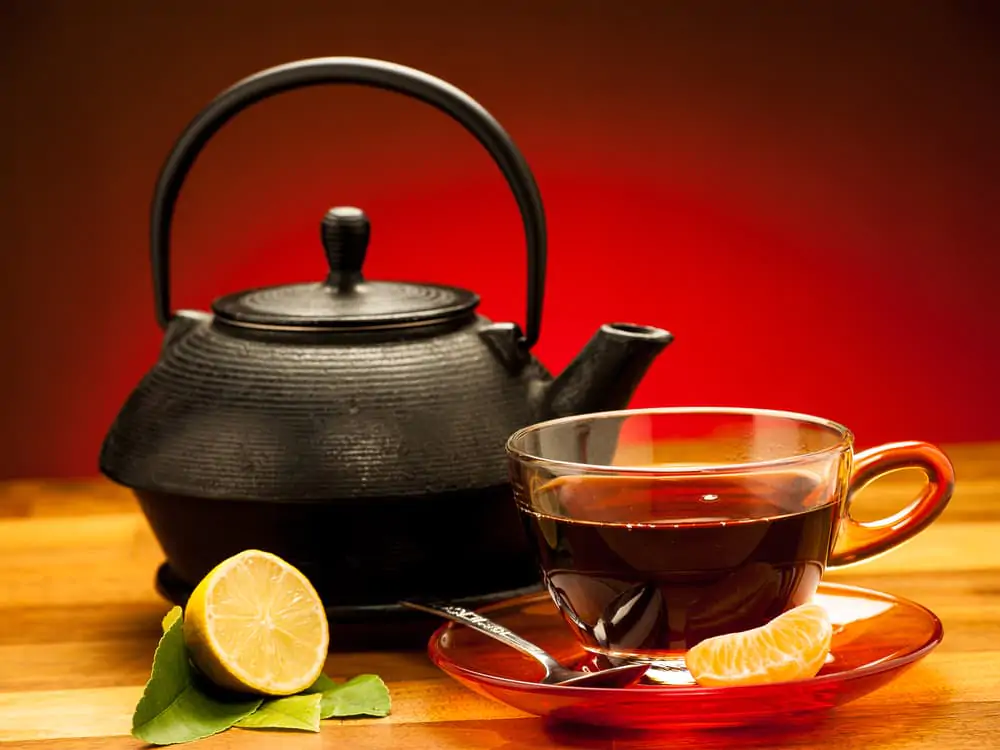What is Orange Pekoe tea? No, it’s not citrus-flavored. It’s a way of grading tea leaves. Here’s a simple breakdown of this tea grading system.

You’re standing in the aisle at the speciality tea store looking over the vast array of tea before you: Green teas. White teas. Black teas. Oolong teas. There are so many to choose from!
You decide on black tea, but you’re now presented with even more options.
Bagged or loose leaf?
Flavored or unflavored?
Unbroken leaves or dust?
What do the words fanning, tippy, and orange pekoe mean?
If you’ve ever looked at all these choices and felt a little lost or overwhelmed, this blog post is for you.
Tea Grading
All classic drinking tea comes from the same plant, Camellia Sinensis. Herbal teas, sometimes called tisanes, are teas made from any plants that aren’t Camellia Sinensis.
Tea is the second most popular drink in the world (second only to water), and modern tea production breaks tea leaves down into grades of differing quality just like the wine and meat industries do.
There are several systems for tea grading. The most familiar system to Americans was developed by the Dutch East India Company in the 1600s and is still used in most Western countries. It specifically processes black teas into grades depending on when they’re harvested and what part of the tea plant they come from.
Asian countries use different grading systems, mostly because green tea is more popular there. Black tea is oxidized, making it easier to store and transport for long periods of time. This led to it becoming the drink of choice in many Western Countries in the 17th and 18th centuries.
Processing tea is done in two ways:
- The traditional manner invented by the Chinese hundreds of years ago is referred to as Orthodox. Orthodox processing is done completely by hand and focuses on protecting the integrity of the tea leaf.
- Modern processing is done by machines and reduces the time and effort needed to process black tea into a form that can be stored, shipped, and drank. The most common modern process is called CTC or crush-tear-curl.
Grades of Black Tea
Black tea grades are given long names, shortened to acronyms, which can be confusing if you’re not sure what they stand for.
You won’t see these terms used by commonly available bagged tea brands, except for the phrase orange pekoe which sometimes appears on boxes of older brands like Red Rose or Lipton. You will really only come across them when you go into a specialty tea shop in a Western country.
Black tea is first divided into 3 categories: Whole leaf, broken leaf, and finally fannings or dust. These are further broken down into categories based on what part of the plant they come from and how big the particles are.
Here is a rundown:
Whole Leaf
Whole leaf teas are just that, teas processed with a focus on protecting the integrity of intact leaves. Whole-leaf teas give a richer, more complex taste and tend to cost more than other types.
Here are some whole-leaf grades you’re likely to come across:
- OP or Orange Pekoe: Pronounced PECK-OH. This refers to the most common, medium-grade tea offered to consumers. Orange Pekoe is made from the uppermost leaves of the plant but without the terminal buds or tips, which are considered higher quality than the leaves and give the tea a richer taste.
- FOP or Flowery Orange Pekoe: These are the uppermost leaves with some of the tips of the plants included.
- GFOP or Golden Flowery Orange Pekoe: The uppermost leaves along with tips picked early in the season, when they have a lovely golden color and delicate flavor.
- TGFOP or Tippy Golden Flowery Orange Pekoe: The uppermost leaves with a large proportion of golden tips.
- Super Fine Tippy Golden Flowery Orange Pekoe: Consists of the finest Orange Pekoe leaves available along with many golden tips.
Broken Leaf
Broken leaf tea consists of large pieces of pekoe tea leaves that have been broken during picking or production. As the broken leaves are processed, they are put through layers of sieves to sort them into uniform sizes. This is so your finished tea, whatever quality it is, will steep evenly.
Broken leaf grades are mostly the same as whole leaf grades, just with a B for broken added.
BOP stands for Broken Orange Pekoe, BFOP is Broken Flowery Orange Pekoe, TGBOP is Tippy Golden Broken Orange Pekoe, and so on.
You might also be interested in our Sassafras tea guide.
Fannings or Dust
Fannings are small pieces of broken tea leaves that are left over after the higher grades have been processed. They are often referred to with the acronym PF, for Pekoe Fannings.
They are considered a low grade of tea leaves and tend to be sold to developing countries at low cost. However, fannings from really high-quality tea can sometimes be more expensive than whole leaf tea of middling quality.
The very smallest fannings are sometimes called tea dust, and you will usually see them used in inexpensive brands of bagged tea.
The Final Word in Orange Pekoe And Tea Grades
So now that you know how tea is graded, we’ve come around to our original question: What does the term orange pekoe really mean?
Pekoe comes from a Chinese term for tea leaves that have tiny white downy hairs on them. The Chinese historically used the term an indicator of quality, but in modern tea grading it just means the unbroken upper leaves of a tea plant.
Orange most likely originated with the Dutch East India Company. The Dutch Royal Family was known as The House of Orange-Nassau when the company first began importing tea into Europe, and the best teas were often reserved for them. When these fine grades of tea were offered to the Dutch public, the word Orange indicated to them it was tea of the highest quality.
FAQs on Orange Pekoe Tea
Is orange pekoe the same as black tea?
Orange pekoe is a term for a certain grade of black tea. It indicates a medium-grade, whole-leaf black tea, and is the most popular grade of tea in the United States. So while all orange pekoe is black tea, not all black tea is orange pekoe. The term is usually printed on tea boxes as a indicator of quality.
What is orange pekoe tea good for?
Orange pekoe tea has traditionally been used to make all kinds of tea drinks in American culture. It is widely used in iced tea, sweet tea, hot tea and sun tea. Research has shown it to have many health benefits: It’s rich in antioxidants, improves gut health, and can lower your blood sugar and cholesterol levels, which makes it healthy for drinking in any manner.
